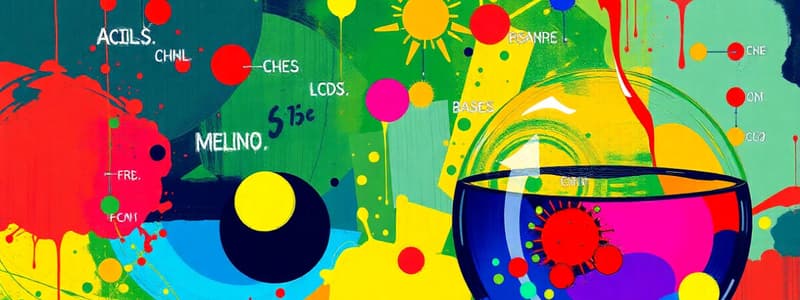Podcast
Questions and Answers
Which of the following compounds would you expect to be insoluble in water?
Which of the following compounds would you expect to be insoluble in water?
- Potassium nitrate ($KNO_3$)
- Silver chloride ($AgCl$) (correct)
- Ammonium carbonate ($(NH_4)_2CO_3$)
- Sodium chloride ($NaCl$)
According to the definitions, a substance that donates protons in a chemical reaction is classified as a base.
According to the definitions, a substance that donates protons in a chemical reaction is classified as a base.
False (B)
What type of gas is produced when hydrochloric acid (HCl) reacts with a metal?
What type of gas is produced when hydrochloric acid (HCl) reacts with a metal?
hydrogen gas
Bases that are soluble in water are called ______.
Bases that are soluble in water are called ______.
In a reaction between sulfuric acid ($H_2SO_4$) and a carbonate, what are the products?
In a reaction between sulfuric acid ($H_2SO_4$) and a carbonate, what are the products?
Match the following indicators with their color in acidic conditions:
Match the following indicators with their color in acidic conditions:
A solution has a pH of 5. According to the pH scale ranges, how would you classify it?
A solution has a pH of 5. According to the pH scale ranges, how would you classify it?
Which of the following is a correct representation of the ions that acids and alkalis produce in aqueous solutions?
Which of the following is a correct representation of the ions that acids and alkalis produce in aqueous solutions?
Flashcards
Soluble ionic compounds
Soluble ionic compounds
Always soluble: Sodium, potassium, ammonium compounds and nitrates.
Proton transfer
Proton transfer
Acids donate protons (H⁺); bases accept protons (H⁺).
Acid/Base definition
Acid/Base definition
Acid: a proton (H⁺) donor; Base: a proton (H⁺) acceptor.
Bases and Alkalis
Bases and Alkalis
Signup and view all the flashcards
Acids/Alkalis in Water
Acids/Alkalis in Water
Signup and view all the flashcards
Acid/Alkali Indicators
Acid/Alkali Indicators
Signup and view all the flashcards
pH Scale Ranges
pH Scale Ranges
Signup and view all the flashcards
Universal Indicator
Universal Indicator
Signup and view all the flashcards
Study Notes
Solubility Rules for Ionic Compounds in Water
- Sodium, potassium, and ammonium compounds are always soluble.
- All nitrates are soluble.
- Chlorides are mostly soluble, with the exception of silver chloride and lead(II) chloride.
- Sulfates are mostly soluble, with the exception of barium sulfate, calcium sulfate, and lead(II) sulfate.
- Carbonates are mostly insoluble, except for sodium, potassium, and ammonium carbonates.
- Hydroxides are mostly insoluble, except for sodium, potassium, and calcium hydroxides (calcium hydroxide is slightly soluble).
Acids and Bases
- Acids are proton (H⁺) donors.
- Bases are proton (H⁺) acceptors.
Acid Reactions
- Hydrochloric acid (HCl) reacts with:
- Metals to form metal chloride and hydrogen gas.
- Bases to form salt and water.
- Carbonates to form salt, water, and carbon dioxide.
- Sulfuric acid (H₂SO₄) reacts with:
- Metals to form metal sulfate and hydrogen gas.
- Bases to form salt and water.
- Carbonates to form salt, water, and carbon dioxide.
- Nitric acid (HNO₃) reacts with:
- Bases to form salt and water.
- Carbonates to form salt, water, and carbon dioxide.
- Nitric acid does not react with metals to produce hydrogen gas.
Bases and Alkalis
- Bases include metal oxides, metal hydroxides, and ammonia.
- Alkalis are bases that are soluble in water, such as NaOH and KOH.
Preparing Soluble Salts
- Soluble salts can be prepared by reacting an acid with an insoluble base (e.g., metal oxide).
- Remove excess insoluble reactant using filtration, then heat the filtrate to evaporate water and obtain crystals.
- Alternatively, they can be prepared by mixing an acid and alkali (neutralization) and evaporating water to obtain crystals.
Preparing Insoluble Salts
- Insoluble salts are prepared by mixing two soluble solutions to form an insoluble precipitate.
- Filter, wash, and dry the precipitate.
Preparing Copper(II) Sulfate Crystals
- Hydrated copper(II) sulfate crystals can be prepared by reacting copper(II) oxide with sulfuric acid.
- Filter and evaporate the solution to form blue crystals of CuSO₄·5H₂O.
Preparing Lead(II) Sulfate
- Lead(II) sulfate is prepared by mixing lead(II) nitrate and sodium sulfate solutions.
- Filter, wash, and dry the white precipitate of PbSO₄.
Acid-Base Indicators
- Litmus is red in acid and blue in alkali.
- Phenolphthalein is colorless in acid and pink in alkali.
- Methyl orange is red in acid and yellow in alkali.
pH Scale
- A pH of 0-3 indicates a strongly acidic solution.
- A pH of 4-6 indicates a weakly acidic solution.
- A pH of 7 is neutral.
- A pH of 8-10 indicates a weakly alkaline solution.
- A pH of 11-14 indicates a strongly alkaline solution.
Universal Indicator
- Universal indicator measures approximate pH by color change across the pH range.
Aqueous Solutions
- Acids are a source of hydrogen ions (H⁺).
- Alkalis are a source of hydroxide ions (OH⁻).
Neutralization
- Alkalis neutralize acids to form salt and water.
Acid-Alkali Titration
- Add acid to alkali (or vice versa) using a burette.
- Use an indicator to determine the endpoint (neutralization).
- Calculate concentration using titration data.
Tests for Gases
- Hydrogen (H₂) burns with a squeaky pop.
- Oxygen (O₂) relights a glowing splint.
- Carbon dioxide (CO₂) turns limewater cloudy.
Calculations
- Amount (mol) = Concentration (mol/dm³) × Volume (dm³)
- This formula can be rearranged to find concentration or volume as needed.
Studying That Suits You
Use AI to generate personalized quizzes and flashcards to suit your learning preferences.




